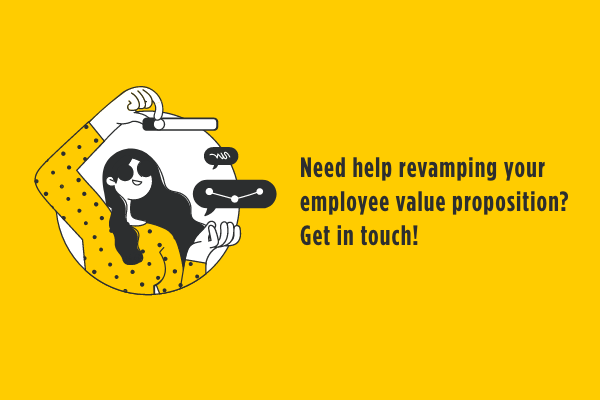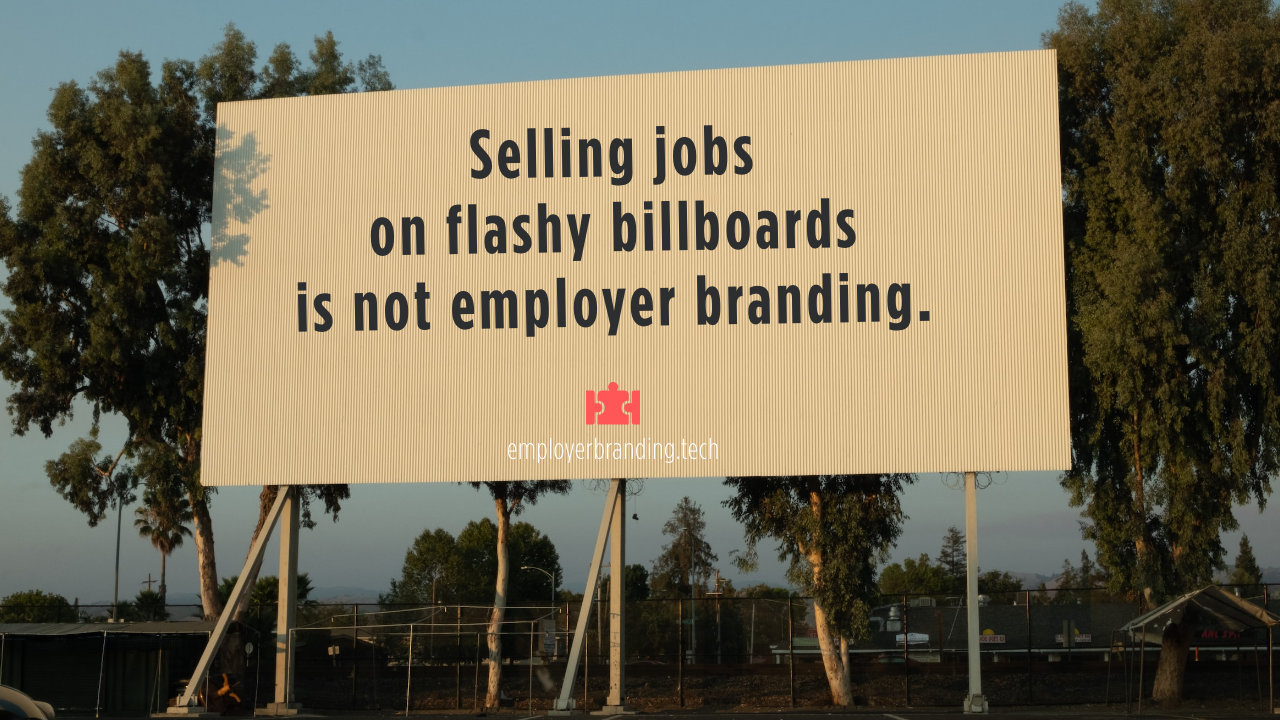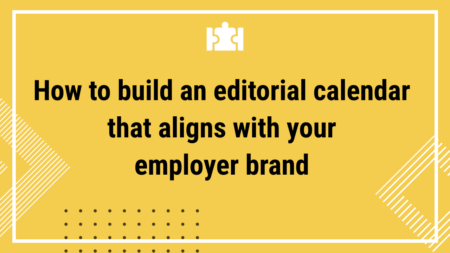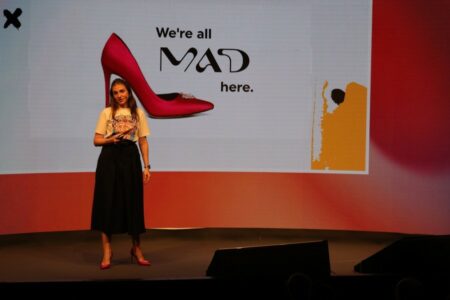Employer branding is a continuous dance between offline & online
As visual beings, we’re drawn by images all the time. The flashier the image the better! For decades, the world of marketing has used visual cues to advertise a product, service, or business. As technology advanced, the offline banners/billboards we’ve gotten used to seeing everywhere are the paid ads we see today in the online realm.
And truth be told, the online realm is glitzier than a Christmas tree! You may not wish to buy the shoes you saw once and can’t afford today, but you probably will three months from now. Can a job ad have the same impact? What about an offline billboard promising you the coolest job? Maybe yes, maybe no.
Recruitment marketing does call for a product marketing mindset. However, there’s a core element influencing a candidate’s decision to apply: the reputation of the company advertising the cool job on the billboard, namely its employer brand.
To the dreamer of unicorns out there, employer branding is a fancy word for “tech recruiter” or “HR manager”. To the practical founder with some knowledge of employer branding, it’s an expensive process that takes too many resources to be implemented. To the CEO, it’s a Pandora’s box with complicated consequences if opened. In the absence of a clear understanding of employer branding, what it is, and how it works, offline job billboards represent the easy way out.
In this blog post, we will talk about the practice of using offline billboards to sell jobs, and how the approach won’t attract and retain the right candidates when used as a standalone strategy. However, when added to an employer branding strategy, offline billboards can have a long-lasting impact.

Just billboards – good for awareness, not so good for recruitment
On a positive note, billboards increase awareness by connecting prospects with a company’s brand messages and catchy images. To become memorable, advertising concepts and creative designs play a key role in the process. In terms of location, the most promising billboards are places in crowded city areas. In our case, the best slots are the tech hubs, bus stations, and streets with intense traffic. Since most commuters use the same route to work, seeing a billboard 10-20 times will drive curiosity. So they’ll probably check out the company and the job advertised online. This is when things get interesting!
Offline advertising is great for building untargeted awareness, but it’s not employer branding. A 6-month paper banner will bring in notable web traffic. The problem is, in tech recruitment companies don’t really want quantity. They want quality, and offline billboards are not enough to get it.
Employer branding is not about advertising your greatness as an employer on an offline billboard. It’s about being one by creating a company culture with clearly-defined values; a culture that cares about its employees just as much as it cares about clients and profits.
Furthermore, employer branding is a process that begins internally. It starts with your current employees and their perception of the company they’re working for. Only after you’ve defined the mission, vision, purpose, EVP, and culture, you can consider offline candidate-oriented advertising as part of your employer branding strategy.
Here’s what usually happens when recruitment is done via billboards only (assuming you’ve already paid to have yours displayed for 6 months):
| The pros | The cons |
| – Notable increase in web traffic – Notable increase in brand awareness | – Untargeted web traffic – Target audience can’t be segmented – Hundreds of unqualified resumes (makes screening candidates difficult and time-consuming for HR) – Increased disappointment of prospects (unmet expectations, what they saw offline doesn’t live up to their expectations when checking you out online) |
Offline billboards can have a long-lasting impact only when included in an employer branding campaign. Increasingly more companies are realizing that recruiting top talent goes beyond the visual, and we’ve seen several amazing initiatives being implemented throughout the city; initiatives with a solid foundation that don’t just leverage billboards to stand out.

Billboards can walk, but they can’t walk the talk in employer branding
What does it mean to “walk the talk” in employer branding? It means to talk less and listen more to what’s happening inside your company. Your current people know your culture better than you. It’s an opportunity, not a chore; a chance to make improvements and truly learn what makes your company unique.
The downside is that business leaders don’t have the time to listen. HR managers feel the pressure to fill in certain roles, and recruiters are too busy hunting for qualified candidates on LinkedIn. An offline billboard seems like the right thing to do because it’s convenient for everyone. Since the product marketing mindset has been imprinted into our human brains, we can’t think of any other solution.
But the world of recruitment is changing, and as a company leader or HR manager, all you do is resist change. What happens when you do that? Others will take your candidates because billboards can’t walk the talk.
Amid a top talent scarcity ruled by unseen candidate expectations, employer branding thrives. At its core, it brings out your uniqueness, emphasizing facts and action rather than bragging. Also, it guarantees that your company will only attract candidates that fit your culture; candidates that won’t leave in 6 months.
When offline meets online recruitment marketing, employer branding shines bright like a diamond. It takes time to strategize and resources to fit all the pieces of the puzzle together. But in the end – meaning 1 year from now, on average – your reputation will precede you.

Nice content, zero context!
Creativity lies at the heart of every employer branding strategy. The story you tell is just as important as the words you use to tell that story. Words placed on a billboard are meaningless without a solid foundation.
That solid foundation is built via an employer branding strategy. As an employer, your ultimate goal is not to be seen by everyone in the city. Your goal is to be seen, accepted, and appreciated by those in your target audience. How do you build appreciation, trust, credibility, and acceptance? How do you make candidates believe in a message on a billboard?
Words alone cannot make anyone believe anything. Taking action will do that. The amazing thing about employer branding is that it draws out both the good and the not-so-good parts of a company. And believe it or not, qualified candidates won’t run away upon hearing the “not so good”. Qualified candidates are aware that a job is a job, and every job is challenging every now and then.
Let’s rethink the status quo of offline billboards in recruitment!
To change the status quo of offline banners and billboards in recruitment, the first step is to acknowledge the inefficiency of such a strategy. The second step is to become more open to alternative recruitment solutions. On average, it costs up to 2,000 EUR to have a banner displayed for 1 month. That’s 12,000 EUR for 6 months of untargeted awareness.
In the beginning, the attention will be flattering. As you realize that attention doesn’t fill in open roles, panic kicks in. Projects are put on hold, HR managers get frustrated, and the competition catches up. What alternatives do you have? Amid fierce competition for attracting and retaining top talent, it’s refreshing to see how employer branding initiatives are thriving throughout the city.
Some companies are combining offline billboards with online tactics to drive curiosity. When what you see is what you get, things change in recruitment. Candidate interest intensifies as they go through your company’s mission and vision. They’re moved by your story, your purpose, your values, and your social media activity.
Employer branding is the mother of all recruitment solutions because it’s an all-encompassing framework. It works beautifully when offline meets the online realm.







